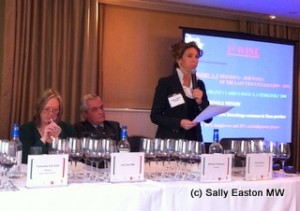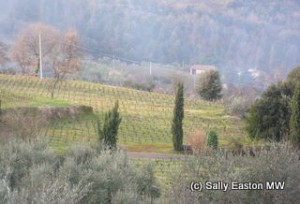IX Selezione dei Vini di Toscana, tasting seminar

Barbara Tamburini presenting, with Jane Hunt MW (l), and Paolo Ignesti of Toscana Promozione (c)
Every two years the Tuscans get together for a big wine competition. For this, the ninth Selezione dei Vini di Toscana, judged in November 2010, Jane Hunt MW and oenologist Barbara Tamburini put together ten medal-winning wines for a seminar to highlight what’s happening in Tuscany at the moment.
Sangiovese is the kingpin of Tuscany, though in the last few decades there have been some international interlopers, some of which have become rather naturalised. In the meantime a lot of work has been done to restore sangiovese to its rightful glory. Tamburini said “many viticultural things have changed in the last 20 years. Oenology gives more value to the wine, but it’s no longer an oenology of correction, that was 30 years ago.”
Hunt added “thirty years ago sangiovese had two problems – high acidity and high tannins. The solution came in the vineyards with the right clones in the right places, and much better management in the vineyards, picking when genuinely ripe [to give] wines with greater suppleness and ripe fruit.”
Tuscany is home to more than a clutch of prestigious appellations – Brunello di Montalcino, Chianti and Chianti Classico, Vino Nobile di Montepulciano, and more recently Morellino di Scansano. Tamburini started to make sense of the region’s diversity by saying “Tuscany is a warm region, but you can divide Tuscany into two, drawing a vertical line dividing the coast from inland.” Some bits are warmer than others. The coast, she said “has temperatures around 16 to 18°C, which the interior is 12 to 14°C. And rainfall at the coast is 600-800m while inland it is 800 to 1,000mm.”

Tuscan hills
Altitude is also significant, she said “there is a fog filter around 300m. Above 300m the sunlight shines directly on the vines without a filter. The aromas of the grapes are synthesised into something special due to the clear atmosphere.”
The coastal area, including Suvereto and Bolgheri “is a place where the climate is about a couple of weeks ahead of the interior of Tuscany. Harvest is usually the last week of September or the first week of October here. This is why producers can make pure cabernet sauvignon, because they get a full and complete maturation of the grapes.”
Hunt added “the now widely planted coastal region was originally a malarial area. It was mainly due to the planting of cabernet sauvignon by Sassicaia, whose first vintage was in 1968. On the back of this success cabernet sauvignon found its place.”
Vintage comments
2005: Tamburini: “A good year, but not as good as 2004 and 2006. There was lots of rain, and those who worked well during the vines’ vegetative period did well.”
2006: Tamburini: “After 2001, 2006 is one of the best vintages, along with 2004, in Tuscany.” There was rain in winter and spring, and no stress in summer.
2007: Hunt: “2007 was a year which had an incredibly hot summer with a bit of welcome rain in August which gives sweet fruitiness. Harvest was 2-3 weeks earlier than it would normally be.”
2008: Hunt: “a vintage with some problems, a lot of rain in the early part of spring. Heat in the summer and rain nearer harvest. A tricky year, but there were some very good wines.”
Tasting notes, London, March 2011, with Hunt and Tamburini comments
Dievole, La Vendemmia 2008, Chianti Classico DOCG
No UK agent.
80% sangiovese, 20% other local varieties. 300 to 420m asl. 13.5%. Fermentation in 80hl casks. For maturation 20% moved to French and American barriques, 1st, 2nd, 3rd use.
Medium deep ruby colour; spicy and redcurrant, bright and crunchy, hint of fresh black tea leaves. Dry and chalky tannins, firm and upright, crunchy and fine grainy tannin, modest body, no great sweetness of fruit. A bit light and balanced for that, savoury, wood notes alongside black tea.
Hunt: “very fruity, with spiciness, with smooth mellow finish. Not too much oak, which is very important for sangiovese.”
Tamburini: “deep colour, red fruits – cherry and raspberry”
Az. Agr. Mannucci Droandi, Foglia Tonda 2008, Toscana IGT Rosso
UK agent: Mille Gusti
Foglia tonda, 250m asl. 13.5%
Chocolate and blackcurrant with herbal garrigue core, perky strawberry and cherry fruit coming through later. Hint of iodine/medicinal attack, with dried black cherry fruit, and fresh core. Light and aromatic. Fresh, and good.
Tamburini: the grape dates from the “1800s. In the past it was used to high quantities of wine. By controlling production, we can make high quality. It has similar clusters to sangiovese, and there is some suggestion that there is a family link to sangiovese.”
Hunt: Foglia tonda “means ‘round leaf’. This is from the extreme south of Tuscany, bordering Umbria; it is warmer than the central Chianti Classico region. There is a sweetness to the fruit, and the tannins are sturdy enough to hold the wine together, but they’re not dominant.”
Fabrizio Dionisio, Il Castagno Syrah 2008, Cortona DOC
UK agent: Grossi Wines
Syrah. 300m asl. 14%. Matured in French oak barriques for 18 months
Medium deep ruby, with purple tints, smoky sweet and perfumed, with gentle aromas. Sweet, smooth attack, and sweet, velvety tannins. Medium bodied, sweet cherry and light plum notes. Good wine, no real sense of place.
Hunt: “cabernet sauvignon was the variety of preference for non-indigenous grape varieties. Syrah has been planted more recently, and I think with huge success. Around Cortona has been very successful with syrah.”
La Fralluca, Pitis 2008, Toscana IGT Rosso
No UK agent
Syrah. 120m asl. 14.3%. Matured in French oak barriques for 18 months
Opaque ruby with purple-blue hints. Bitter chocolate, minty, menthol, a hint of the Barossa on the nose. Big wine. Chewy, yet supple tannins, big and plentiful. Nothing subtle about this style. Nice wine, with smooth chewiness to tannins, and big muscular concentration, with overt new oak and alcohol, with youthful, dry tannins to finish.
Tamburini: “Suvereto is an area just in from the coast in front of Elba island. It has a special climate thanks to Elba island. In August and September storms and rains from the sea [are deflected] by Elba, so it doesn’t rain too much” in Elba’s rain shadow. “You taste the vanilla of oak, it’s very spicy. In the mouth, it’s something we can eat rather than drink. It’s dense with many tannins.”
Hunt: “the contrast of the two syrahs is mainly due to climate. This one from coast with low rainfall and hotter than the central area.
Az. Agr. Roccapesta, Roccapesta 2007, Morellino di Scansano DOCG
UK agent: HS Wines
Sangiovese 96%, ciliegiolo 4%. 300m asl. 14.7%
Medium light ruby colour. Hint of aromatic tar on the nose. Dry baked red berry fruits. Ripely aromatic with some layers of complexity. Sweet baked fruit attack, medium fragrant body, smooth, light, intense and layered. Savoury black tea finish with sweated berry fruit. Vg.
Tamburini: on this wine there is a “triple selection: once in the vineyard, then a selection of the cluster, then a selection of the berries after destemming.” The wine is “fresh in the mouth, dark cherry, ripe and elegant, and not too concentrated.”
Hunt: “Morellino means ‘the little dark one’, but often it’s a little lighter in colour and texture, fruitier, and not as heavy as some of the Chianti Classico. This has a lightness and perfume to it despite its alcohol.”
Castello Vicchiomaggio, “Vigna La Prima 2007, Chianti Classico DOCG Riserva
UK agent: Hallgarten
Sangiovese. 300m asl. 14.5%.
Bright, dark chocolate-dipped black cherries on the nose, aromatic tarry note with black tea leaf undertones, complex and layered nose. Supple, sweet attack, with beguiling freshness of core, sweet fruit wraps freshly around the backbone of smooth, finely-textured fresh tannin. Medium weight, elegant with super concentration of fruit. Balanced and long. Vg.
Hunt: “a quintessential Chianti Classico with perfume, savoury, sweet-sour ripe cherries aromas. A near perfect Chianti Classico. This estate maintains a traditional and elegant style.”
Gualdo del Re, Federico Primo 2007, Val di Cornia DOC Suvereto Cabernet Sauvignon
No UK agent
Cabernet sauvignon. 100m asl. 14.7%. New barrique maturation for 70% of this wine, made by Barbara Tamburini.
Dark ruby, almost opaque, with sweet vanilla nose of blackberries and cream. Palate reflects nose, smooth texture, with grainy, youthful fine-chunky plentiful tannins. Lush and sweet fruit, dark and chocolatey. Mouthfilling and open knit texture, warm and warming. Good.
Hunt: “Violet aroma, good varietal character without aggressive bell pepper aroma.”
Col d’Orcia, Brunello di Montalcino DOCG 2006
UK agent Alivini
Sangiovese. 300-320m asl. 14%. Three years in large French and Slavonian casks of 25, 50 and 75hl.
Medium pale ruby. Tar, tea, roses, lifted nose, and perfumed. Savoury tea and teacake attack, with dried cherries and dark chocolate. Elegant, perfumed, silky-floaty tannins. Savoury, with fine-grainy finish. Concentration with lightness of being. Vg.
Tamburini: “it has a traditional style, the nose with its evolution of tertiary notes from ageing in barrels, especially in big barrels. It will become more complex in the future. It’s a very young wine.”
Hunt: “One of the crucial factors for long lived wine is good acidity. Though this is grown in a warm area with low rainfall, the natural acidity in the grapes allows longevity.”
Tenuta Agricola Torre a Cenaia, Torre del Vajo 2006, Toscana IGT Rosso
Sangiovese, cabernet sauvignon, syrah. Near sea level. 13.6%
Medium deep ruby colour. Blackcurrant and black cherries on nose and palate. Rich and sweet aromas, vanilla ice cream, subtle and enticing. Then a fresh cherry perfume emerges. Medium weight, quite crunchy/youthful primary fruit, and fine grained tannins with a bit of grip and youthful dryness. I might say a bit foursquare/rustic, but with a sweet fruitiness.
Peteglia, Peteglia Sangiovese Riserva 2005, Montecucco DOC
Sangiovese. 300m asl. 14.9%
Deep garnet with mahogany rim. Chocolate and fruit cake, quite evolved and developed. Smouldering wood fire aroma. More for academic interest. This bottle has reached full potential, the wine is gentle, venerable, with tertiary, leather, undergrowth notes.



